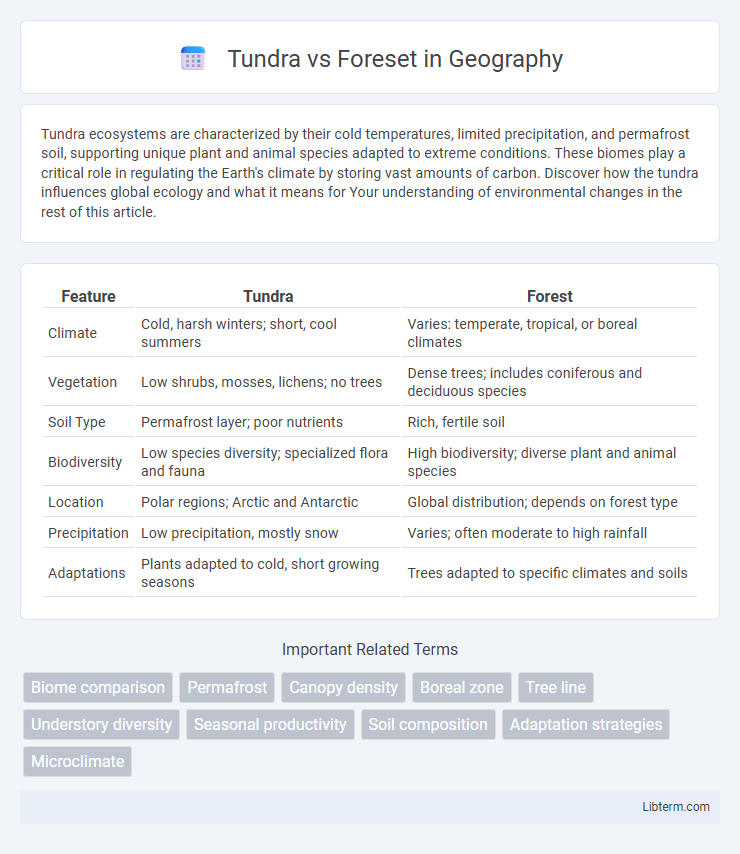Tundra ecosystems are characterized by their cold temperatures, limited precipitation, and permafrost soil, supporting unique plant and animal species adapted to extreme conditions. These biomes play a critical role in regulating the Earth's climate by storing vast amounts of carbon. Discover how the tundra influences global ecology and what it means for Your understanding of environmental changes in the rest of this article.
Table of Comparison
| Feature | Tundra | Forest |
|---|---|---|
| Climate | Cold, harsh winters; short, cool summers | Varies: temperate, tropical, or boreal climates |
| Vegetation | Low shrubs, mosses, lichens; no trees | Dense trees; includes coniferous and deciduous species |
| Soil Type | Permafrost layer; poor nutrients | Rich, fertile soil |
| Biodiversity | Low species diversity; specialized flora and fauna | High biodiversity; diverse plant and animal species |
| Location | Polar regions; Arctic and Antarctic | Global distribution; depends on forest type |
| Precipitation | Low precipitation, mostly snow | Varies; often moderate to high rainfall |
| Adaptations | Plants adapted to cold, short growing seasons | Trees adapted to specific climates and soils |
Understanding the Tundra: Key Characteristics
Tundra ecosystems are characterized by permafrost, low temperatures, and minimal vegetation primarily consisting of mosses, lichens, and dwarf shrubs, distinguishing them from forested areas dominated by tall trees and dense plant life. The harsh climatic conditions and short growing seasons in the tundra limit biodiversity and productivity compared to forests. Understanding these key characteristics is essential for studying climate adaptation, carbon cycling, and ecosystem dynamics in Arctic and sub-Arctic regions.
Exploring Forest Ecosystems: Definition and Types
Forest ecosystems encompass diverse types, including tropical rainforests, temperate forests, and boreal forests, each characterized by distinct climate conditions, flora, and fauna. The tundra, by contrast, features a treeless landscape dominated by mosses, lichens, and low shrubs, adapted to cold, arid environments with permafrost soils. Exploring these ecosystems reveals how forest types support biodiversity and carbon sequestration, while tundra regions play a critical role in climate regulation and habitat provision for specialized species.
Climate Differences: Tundra vs Forest
Tundra climates are characterized by extremely cold temperatures, low precipitation primarily in the form of snow, and a short growing season, resulting in permafrost and minimal vegetation. Forest climates exhibit more moderate temperatures with distinct seasonal variations, higher precipitation levels supporting diverse plant life, and no permafrost presence. Temperature averages in tundra regions often stay below freezing for most of the year, while forest regions experience warmer summers and milder winters.
Soil Composition and Fertility Comparison
Tundra soil is characterized by permafrost layers, limited organic material, and poor nutrient availability, resulting in low fertility and slow decomposition rates. Forest soils typically exhibit rich organic horizons, well-developed profiles, and higher nutrient content due to leaf litter and microbial activity, enhancing soil fertility. The contrast in soil composition and fertility directly influences plant diversity and ecosystem productivity between tundra and forest biomes.
Biodiversity: Flora and Fauna in Tundra and Forests
Tundra ecosystems exhibit low biodiversity with specialized flora such as mosses, lichens, and dwarf shrubs adapted to cold, nutrient-poor soils, and fauna including caribou, arctic foxes, and migratory birds specialized for extreme conditions. In contrast, forests support high biodiversity with diverse tree species like oaks, pines, and maples, alongside a rich array of mammals, birds, and insects thriving in abundant vegetation and varied habitats. Forests provide layered vegetation structures that create niches for complex food webs, while tundra's simpler plant communities limit species diversity.
Adaptations of Plants and Animals
Tundra plants exhibit adaptations such as shallow root systems, small leaves, and antifreeze proteins to survive freezing temperatures and nutrient-poor soils, while tundra animals have thick fur, fat layers, and hibernation behaviors to endure extreme cold. In contrast, forest ecosystems host plants with deep roots, broad leaves, and seasonal dormancy adapted to varied light and nutrient availability, and animals often rely on camouflage, migration, and diverse diets to thrive year-round. These specific physiological and behavioral adaptations enable both tundra and forest species to optimize survival in their distinct environmental conditions.
Human Impact and Conservation Efforts
Human impact on tundra ecosystems includes oil drilling, mining, and infrastructure development, which disrupt permafrost and fragile habitats. Forests face deforestation, logging, and land conversion for agriculture, leading to biodiversity loss and carbon release. Conservation efforts in tundra prioritize protection of permafrost zones and sustainable resource use, while forest conservation emphasizes reforestation, protected areas, and sustainable forestry practices to maintain ecological balance.
Resource Availability and Ecosystem Services
Tundra ecosystems exhibit limited resource availability due to permafrost and low nutrient levels, restricting plant growth and reducing biodiversity, while providing crucial ecosystem services such as carbon sequestration and habitat for migratory species. Forests offer abundant resources like diverse timber, medicinal plants, and rich soil nutrients, supporting higher biodiversity and complex food webs. Both ecosystems deliver vital services; forests contribute significantly to oxygen production, climate regulation, and soil stabilization, whereas tundras play key roles in climate moderation and preserving unique Arctic species.
Seasonal Changes and Their Effects
Tundra experiences extreme seasonal changes with long, harsh winters and short, cool summers, causing permafrost layers to freeze and thaw, impacting soil stability and vegetation growth. Forests exhibit more moderate seasonal variations, with deciduous trees shedding leaves in autumn and regrowing in spring, allowing diverse flora and fauna to thrive through cyclical nutrient recycling. These differences lead to tundras supporting limited biodiversity and slow ecosystem recovery, while forests sustain rich ecosystems with dynamic seasonal productivity.
Tundra vs Forest: Which Is More Vulnerable to Climate Change?
Tundras are more vulnerable to climate change than forests due to their sensitivity to temperature fluctuations and permafrost thawing, which disrupts native vegetation and soil stability. Forests, while affected by increased drought, wildfires, and pest outbreaks, exhibit greater resilience through species diversity and adaptive growth. Permafrost degradation in tundras releases significant greenhouse gases, accelerating global warming and amplifying ecosystem vulnerability.
Tundra Infographic

 libterm.com
libterm.com